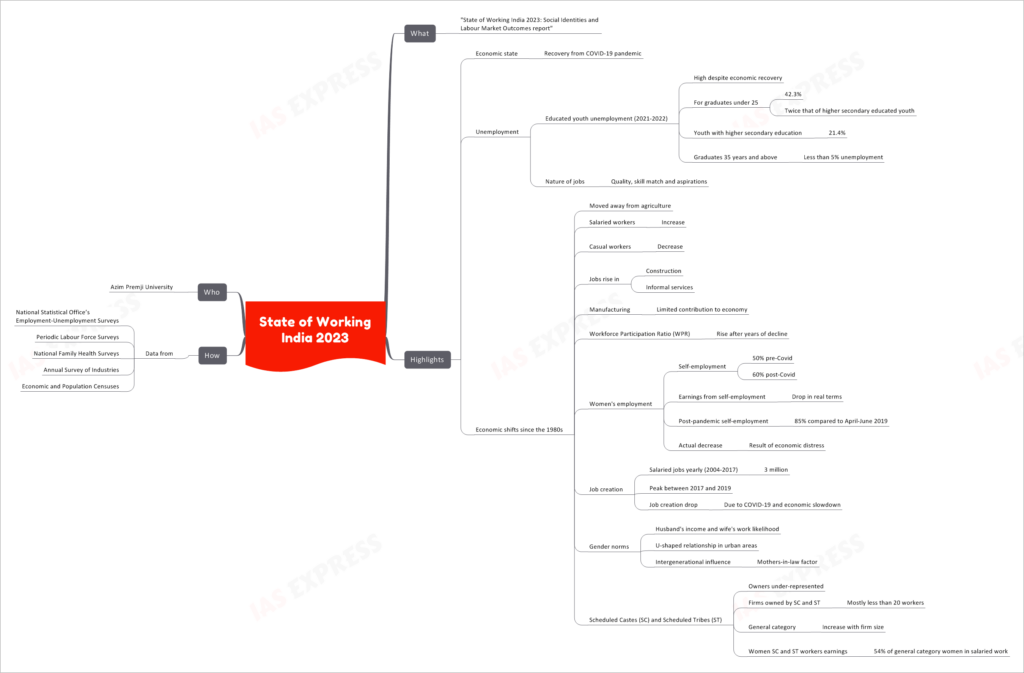State of Working India 2023

The “State of Working India 2023: Social Identities and Labour Market Outcomes” report, published by Azim Premji University, provides a comprehensive analysis of the economic state of India, focusing on the recovery from the COVID-19 pandemic and its impact on various aspects of the labor market. This report draws upon data from various sources, including the National Statistical Office’s Employment-Unemployment Surveys, Periodic Labour Force Surveys, National Family Health Surveys, Annual Survey of Industries, and Economic and Population Censuses.
This topic of “State of Working India 2023” is important from the perspective of the UPSC IAS Examination, which falls under General Studies Portion.
Economic State and Recovery
The report begins by addressing the economic state of India and the ongoing recovery from the COVID-19 pandemic.
Unemployment among Educated Youth (2021-2022)
Despite signs of economic recovery, the report highlights persistently high unemployment rates among educated youth. Notable statistics include:
- Graduates Under 25: Unemployment rate at a staggering 42.3%, which is twice that of higher secondary educated youth.
- Youth with Higher Secondary Education: Unemployment rate stands at 21.4%.
- Graduates Aged 35 and Above: Less than 5% unemployment, indicating greater job stability.
Nature of Jobs
The report examines the nature of jobs in India, considering factors such as job quality, skill match, and aspirations.
Economic Shifts Since the 1980s
India’s economic landscape has undergone significant changes since the 1980s, including:
- A shift away from agriculture as a dominant sector.
- An increase in the number of salaried workers.
- A decrease in casual labor.
- A rise in jobs within the construction and informal services sectors.
- Limited contribution of manufacturing to the economy.
Workforce Participation Ratio (WPR)
The report notes a positive trend in the Workforce Participation Ratio (WPR) after years of decline, suggesting increased labor force engagement.
Women’s Employment
Gender dynamics in the labor market are explored, with a focus on women’s employment:
- Pre-COVID self-employment among women at 50%, increasing to 60% post-COVID.
- A drop in real earnings from self-employment.
- Post-pandemic self-employment at 85% compared to April-June 2019, indicative of economic distress.
Job Creation
The report provides insights into job creation trends:
- An annual creation of 3 million salaried jobs between 2004 and 2017.
- A peak in job creation between 2017 and 2019.
- A subsequent drop in job creation due to the impact of COVID-19 and economic slowdown.
Gender Norms
The report explores the relationship between gender norms, husband’s income, and a wife’s likelihood to work, revealing a U-shaped relationship in urban areas and intergenerational influences, including the role of mothers-in-law.
Scheduled Castes (SC) and Scheduled Tribes (ST)
The report sheds light on the representation of SC and ST communities in the labor market:
- SC and ST owners are under-represented in the workforce.
- Firms owned by SC and ST individuals tend to be smaller, with mostly less than 20 workers.
- In contrast, the general category shows an increase in firm size.
- Women from SC and ST communities in salaried work earn only 54% of what general category women earn.

